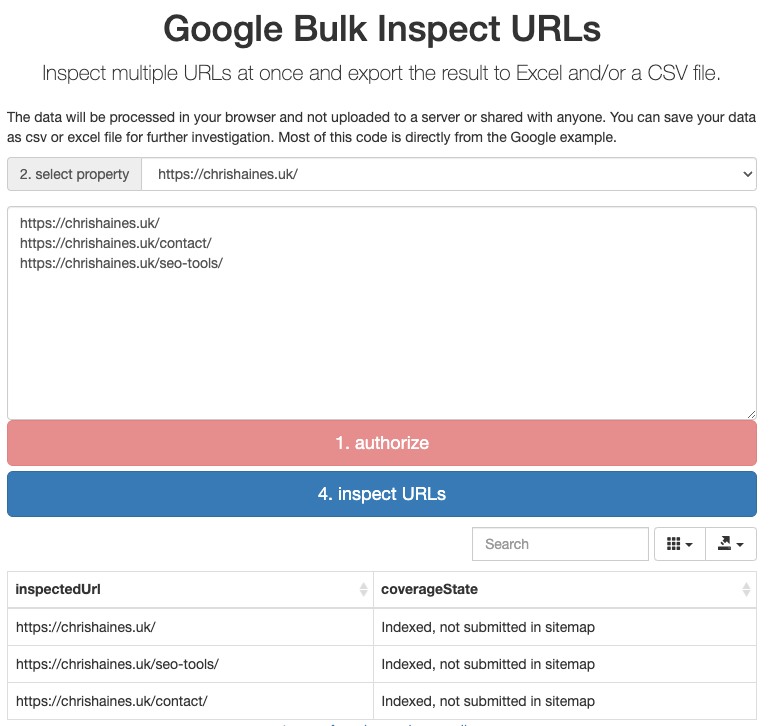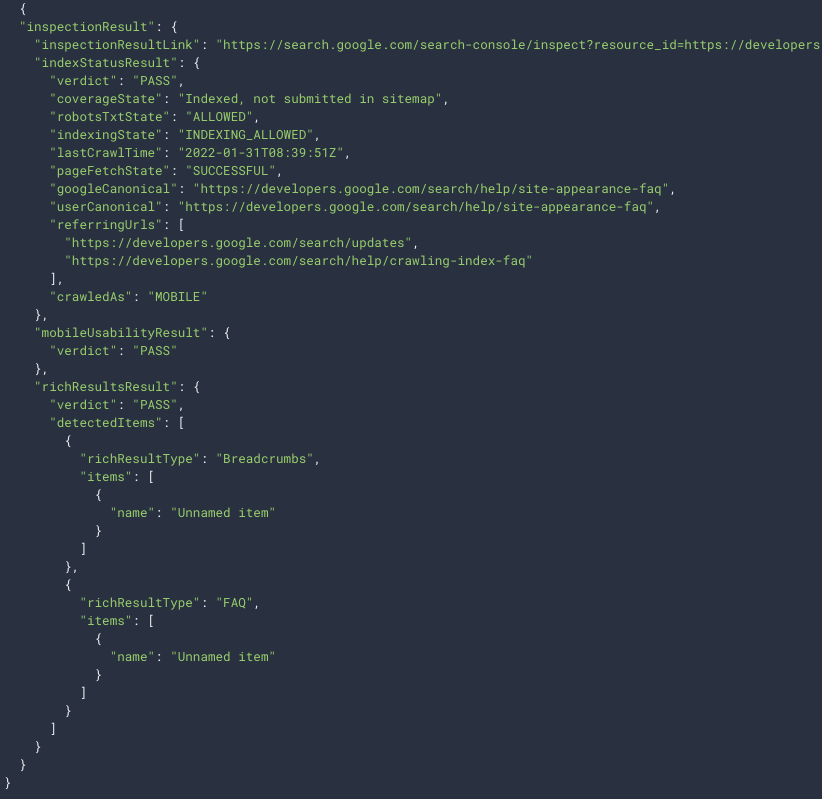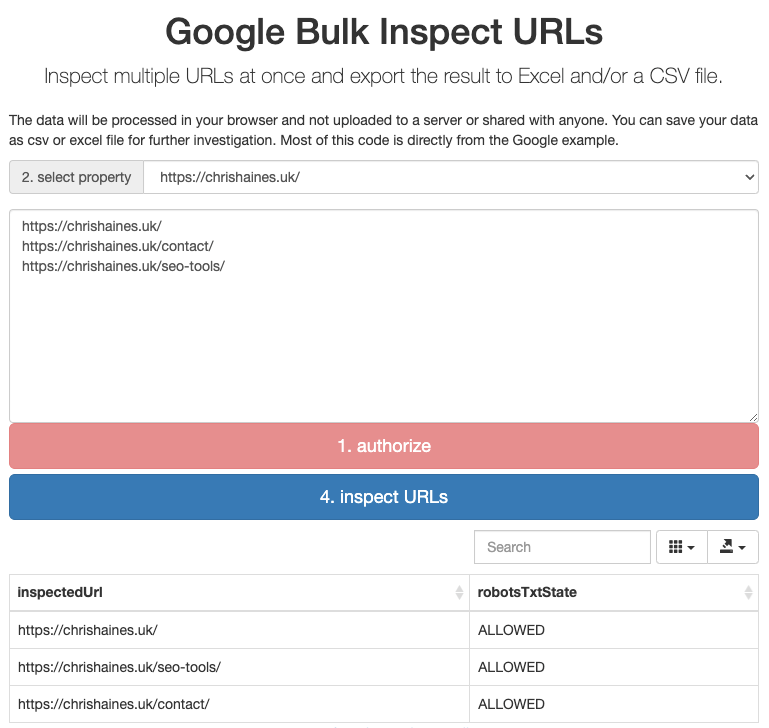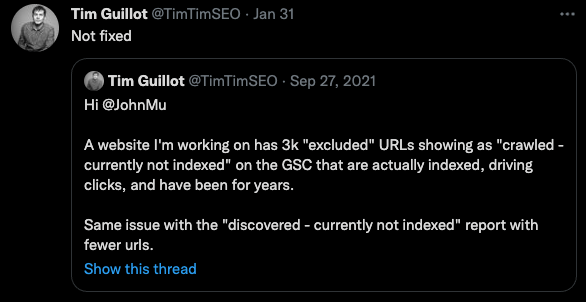Google’s New Seek Console URL Inspection API: What It Is & The best way to Use It #search engine optimization Information
 [ad_1]
[ad_1]
Diagnosing technical problems to your site may also be one of the vital time-consuming however vital facets of working a site.
To make issues worse, Google best lets you check out one URL at a time to diagnose doable problems to your site (that is executed inside of Google Seek Console).
Fortuitously, there may be now a sooner approach to take a look at your site: input the Google Seek Console URL Inspection API…
What's the Google Seek Console URL Inspection API?
The Google Seek Console URL Inspection API is a approach to bulk-check the information that Google Seek Console has on URLs. Its objective is to lend a hand builders and SEOs extra successfully debug and optimize their pages the use of Google’s personal information.
Right here’s an instance of me the use of the API to test whether or not a couple of URLs are listed and submitted in my sitemap:

What form of information are you able to get from the Google Seek Console URL Inspection API?
The Google Seek Console URL Inspection API lets you pull a variety of information. Beneath is a listing of one of the maximum mentioned options:
lastCrawlTime
With this box, you'll perceive precisely when Googlebot final crawled your site. That is extraordinarily helpful for SEOs and builders to measure the frequency of Google’s crawling in their websites. Up to now, it's essential best get get entry to to this kind of information thru log report research or spot-checking person URLs with Google Seek Console.
robotsTxtState
With this box, you'll perceive whether or not you've gotten any robots.txt regulations that may block Googlebot. That is one thing you'll verify manually, however with the ability to take a look at it at scale with Google’s personal information is an out of this world step ahead.
googleCanonical and userCanonical
In some scenarios, Google has been recognized to make a choice a unique canonical from the one who has been specified within the code. On this state of affairs, with the ability to examine each (facet by means of facet and at scale) the use of the API comes in handy for enabling you to make the right adjustments.
crawledAs
This box lets you perceive which consumer agent is used for a move slowly of your web site: Cell/Desktop. The reaction codes are under for reference:
- DESKTOP – Desktop consumer agent
- MOBILE – Cell consumer agent
pageFetchState
Figuring out the pageFetchState allow you to diagnose server mistakes, no longer discovered 4xxs, comfortable 404s, redirection mistakes, pages blocked by means of robots.txt, and invalid URLs. A listing of responses is under for reference.
| Box | What it approach |
|---|---|
| PAGE_FETCH_STATE_UNSPECIFIED | Unknown fetch state |
| SUCCESSFUL | A success fetch |
| SOFT_404 | Cushy 404 |
| BLOCKED_ROBOTS_TXT | Blocked by means of robots.txt |
| NOT_FOUND | Now not discovered (404) |
| ACCESS_DENIED | Blocked because of unauthorized request (401) |
| SERVER_ERROR | Server error (5xx) |
| REDIRECT_ERROR | Redirection error |
| ACCESS_FORBIDDEN | Blocked because of get entry to forbidden (403) |
| BLOCKED_4XX | Blocked because of different 4xx factor (no longer 403, 404) |
| INTERNAL_CRAWL_ERROR | Inner error |
| INVALID_URL | Invalid URL |
indexingState
The indexing state tells you the present standing of indexation for the URLs. Except for the extra obtrusive Go and Fail responses, there are different responses:
- NEUTRAL is an identical to the “Excluded” message in Seek Console.
- PARTIAL is an identical to the “Legitimate with warnings” message in Seek Console.
- VERDICT_UNSPECIFIED signifies that Google is not able to return to a conclusion concerning the URL(s) in query.
coverageState
This will provide you with element on whether or not a URL has been submitted to your sitemap and listed.
referringUrls
This lets you see the place each and every web page is related from, consistent with Google.
Sitemap
This lets you perceive which URLs are integrated within the sitemap(s).
Different makes use of for the API
You'll be able to additionally use the API to check out your AMP web site—if in case you have one.
The best way to use the Google Seek Console URL Inspection API step by means of step
The usage of the Google Seek Console URL Inspection API comes to creating a request to Google. The request parameters you want to outline are the URL that you need to check out and likewise the URL of the valuables in Google Seek Console.
The request frame incorporates information with the next construction:

In case you are curious to be informed extra about how you can use the API, Google has intensive documentation about this.
Beneath is an instance of the kind of reaction you'll get from the API:

In the event you’re no longer ok with code or simply wish to give it a cross instantly, you'll use valentin.app’s loose Google Bulk Check out URLs software. The software supplies a snappy approach to question the API with none coding talents!
Right here’s how you can use it. You can:
- Pass to https://valentin.app/check out.html, authorize get entry to on your Google account, and choose the Seek Console belongings you need to check. Then paste your URLs into the field under. (The knowledge will likely be processed to your browser and no longer uploaded to a server or shared with any individual.)
- Click on the “Check out URLs” button. The knowledge will begin to pull from the API.
- Export the information as a CSV or Excel report by means of clicking the button.
- Analyze the information and verify for any doable problems.
How are you able to use the Google Seek Console URL Inspection API in follow?
In concept, the Google Seek Console URL Inspection API turns out like a good way to grasp extra about your site. Then again, you'll pull such a lot information that it’s tricky to understand the place to begin. So let’s take a look at a couple of examples of use instances.
1. Web site migration – diagnosing any technical problems
Web site migrations could cause a wide variety of problems. As an example, builders can by accident block Google from crawling your web site or positive pages by means of robots.txt.
Fortuitously, the Google Seek Console URL Inspection API makes auditing for those problems a doddle.
As an example, you'll verify whether or not you’re blockading Googlebot from crawling URLs in bulk by means of calling robotsTxtState.
This is an instance of me the use of the Google Seek Console URL Inspection API (by means of valentin.app) to name robotsTxtState to peer the present standing of my URLs.

As you'll see, those pages don't seem to be blocked by means of robots.txt, and there aren't any problems right here.
TIP
2. Perceive if Google has revered your declared canonicals
If you're making a transformation to the canonical tags throughout your web site, it would be best to know whether or not or no longer Google is respecting them.
You can be questioning why Google ignores the canonical that you simply declared. Google can do that for a lot of causes, for instance:
- Your declared canonical isn't https. (Google prefers https for canonicals.)
- Google has selected a web page that it believes is a greater canonical web page than your declared canonical.
- Your declared canonical is a noindex web page.
Beneath is an instance of me the use of the Google Seek Console URL Inspection API to peer whether or not Google has revered my declared canonicals:

As we will see from the above screenshot, there aren't any problems with those explicit pages and Google is respecting the canonicals.
TIP
To temporarily see if the googleCanonical fits the userCanonical, export the information from the Google Bulk Check out URLs software to CSV and use an IF method in Excel. As an example, assuming your googleCanonical information is in Column A and your userCanonical is in Column B, you'll use the method =IF(A2=B2, “Self referencing”,”Non Self Referencing”) to test for non-matching canonicals.
3. Perceive when Google recrawls after you're making adjustments on your web site
While you replace many pages to your site, it would be best to know the have an effect on of your efforts. This will best occur after Google has recrawled your web site.
With the Google Seek Console URL Inspection API, you'll see the appropriate time Google crawled your pages by means of the use of lastCrawlTime.
If you'll’t get get entry to to the log information on your site, then it is a nice choice to know how Google crawls your web site.
Right here’s an instance of me checking this:

As you'll see within the screenshot above, lastCrawlTime displays the date and time my site used to be crawled. On this instance, the latest move slowly by means of Google is the homepage.
Figuring out when Google recrawls your site following any adjustments will permit you to hyperlink whether or not or no longer the adjustments you made have any certain or destructive have an effect on following Google’s move slowly.
FAQs
The best way to get across the Google Seek Console URL Inspection API limits?
Even though the Google Seek Console URL Inspection API is restricted to two,000 queries according to day, this question restrict is decided by means of Google Belongings.
This approach you'll have more than one houses inside of one site if they're verified one by one in Google Seek Console, successfully permitting you to circumvent the restrict of two,000 queries according to day.
Google Seek Console lets you have 1,000 houses to your Google Seek Console account, so this will have to be greater than sufficient for many customers.
Can I exploit the Google Seek Console URL Inspection API on any site?
Every other doable restricting issue is you'll best run the Google Seek Console URL Inspection API on a belongings that you simply personal in Google Seek Console. In the event you don’t have get entry to to the valuables, then you can't audit it the use of the Google Seek Console URL Inspection API.
So this implies auditing a web site that you simply don’t have get entry to to may also be problematic.
How correct is the information?
Accuracy of the information itself has been a subject matter for Google over the previous few years. This API will provide you with get entry to to that information. So arguably, the Google Seek Console URL Inspection API is best as excellent as the information inside of it.

As we've up to now proven in our learn about of Google Key phrase Planner’s accuracy, information from Google is continuously no longer as correct as folks suppose it to be.
Ultimate ideas
The Google Seek Console URL Inspection API is a good way for web site house owners to get bulk information immediately from Google on a bigger scale than what used to be up to now conceivable from Google Seek Console.
Daniel Waisberg and the staff at the back of the Google Seek Console URL Inspection API have undoubtedly executed a really perfect activity of having this launched into the wild.
However probably the most criticisms of the Google Seek Console URL Inspection API from the search engine optimization group is that the question charge restrict is simply too low for better websites. (It's capped at 2,000 queries according to day, according to belongings.)
For better websites, this isn't sufficient. Additionally, in spite of the conceivable workarounds, this quantity nonetheless appears to be at the low facet.
What’s your revel in of the use of the Google Seek Console URL Inspection API? Were given extra questions? Ping me on Twitter. 🙂
Comments
Post a Comment